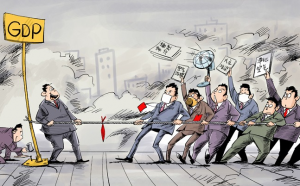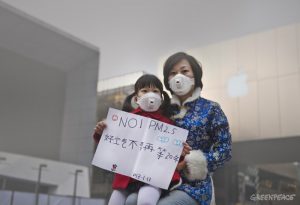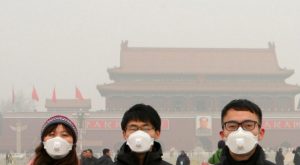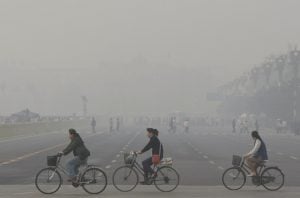Beijing has finally decided to do something about its air pollution. Last week, the city announced a multibillion yuan campaign to tackle its environmental problems, an urgent follow up to last month’s parliamentary sessions, where the capital’s infamous air pollution – dubbed “airpocalypse" by the media – was the subject everyone was talking about.
The environmental investment plan will see 100 billion yuan spent on areas including sewage treatment and air pollution over three years, according to state media. Beijing will also start to implement its 2013 Clean Air Action Plan, which contains a variety of measures aimed at bringing down the city’s major pollutants by a modest 2% in 2013.
Despite these initiatives, policymakers failed to address the elephant in the room. Action to tackle Beijing’s air pollution cannot be seen as serious without parallel efforts to stall growth in regional coal consumption. This, however, is beyond the scope of Beijing’s plan and requires collective efforts from neighbouring provinces.
Both official statistics and scientific assessments show that coal-burning is the largest source of the three main pollutants linked to PM2.5: sulphur oxide, nitrogen oxide and primary particulate matter. PM2.5 is shorthand for fine particulates measuring 2.5 microns or less in diameter, which have been at the centre of the public furore over air quality in China over the past two years.
In addition, Beijing’s air pollution problem is, to a large extent, regional and trans-boundary. According to one study published in the journal Atmospheric Chemistry and Physics, an average of 39% of Beijing’s PM2.5 comes from emission sources outside the city. The same study also found that when there are sustained winds from the south, namely from Hebei and Shandong provinces, non-Beijing airborne pollutants can contribute 50-70% of the capital’s PM2.5 levels.
The need for a regional coal cap
A quick flick through China’s energy statistics book tells us just how coal-addicted Beijing’s neighbours are. In 2011, Shandong and Hebei collectively consumed nearly 700 million tonnes of coal, making them the first and fourth biggest consumers among China’s provinces. Each burned through more coal than Germany, Europe’s largest economy, and together they exceeded India’s total coal consumption. Putting it another way, more coal is consumed within 600 kilometres of China’s capital than in the entire United States.
The crucial need to control coal use and address air pollution at a regional level is driven home by the scale of Hebei’s energy consumption within the Jing-jin-ji (Beijing, Tianjin, Hebei) region. Hebei is responsible for 80% of coal consumption within the region, and 77-90% of the emissions of the three main pollutants.
Even if Beijing can immediately achieve its proposed annual coal cap of 15-million tonnes (which translates into a saving of about 7 million tonnes of coal) this reduction is significantly overshadowed by the huge energy appetite of Hebei. Without any movement from Hebei, the emission control guarantee from the new Beijing Mayor Wang Anshun is merely a palliative measure, rather than a breakthrough cure.
More worrying perhaps, is that while Beijing has managed to cut its own emissions swiftly, pollution from Shandong and Hebei increased dramatically in 2011. A decline in emissions thanks to the installation of sulphur-dioxide pollution control equipment in power plants between 2005 and 2010 has been followed by a staggering rise. Hebei’s SO2 emissions increased 15% in 2011, while Shandong’s rose by 19%, according to recent statistics.
The inconvenient truth is that progress in emission intensity brought about by technological advancement has been more than offset by the pace of aggregate coal consumption growth. In coming years, further gains will become even harder and more expensive to achieve, as the low-hanging fruit is taken.
Strong absolute coal caps are needed not only for Beijing, but also surrounding provinces. We haven’t, however, seen corresponding measures from Hebei and Shandong. Neither have we seen any concrete progress or timetable of implementation for the long proposed mechanism to coordinate regional air pollution control.
Mounting concern over health
The time for policy action is increasingly limited. Air pollution is already taking a heavy toll on a restive public. An estimated 8,572 premature deaths occurred in Beijing, Shanghai, Guangzhou, and Xi’an – four major Chinese cities – last year due to high levels of PM2.5 pollution, and caused US$1.08 billion in economic losses, according to research by Greenpeace and Peking University’s School of Public Health. A separate study by the WHO Global Burden of Disease project suggests that PM2.5 caused 1.2 million deaths in 2010 in China.
Worse, Greenpeace projects that, based on 2008 to 2012 reduction rates in particulate-matter concentrations, and given current policy efforts, Beijing will only meet the national air quality standard in 2031. That means it will take even longer for Beijing to meet the World Health Organisation standard, since the current national standard is looser than the international one.
A feasible roadmap to get rid of coal has already been outlined by various commentators. Deutsche Bank said in a recent report that nothing less than “big bang” measures could combat China’s air pollution, and recommended the country halve its coal-consumption annual growth rate from the 4% currently forecast for 2013 to 2017. Another 22% of coal consumption should be cut from 2017 to 2030, the bank said. It also called for a reduction in coal-related emissions by about 70% over the next 18 years.
Two pathways are unfolding in front of China’s policymakers. The path of unbridled, unsustainable GDP growth at all costs that ignores the health of its citizens, or a greener, cleaner kind of growth powered by smart investments in new energy, and guided by effective environmental policies and practices. As the nation’s renowned respiratory expert Zhong Nanshan bluntly put it on the sidelines of the parliamentary meetings last month: “When people’s health is at risk, how can we still put GDP first?"
Li Shuo and Lauri Myllyvirta are climate and energy campaigners at Greenpeace



